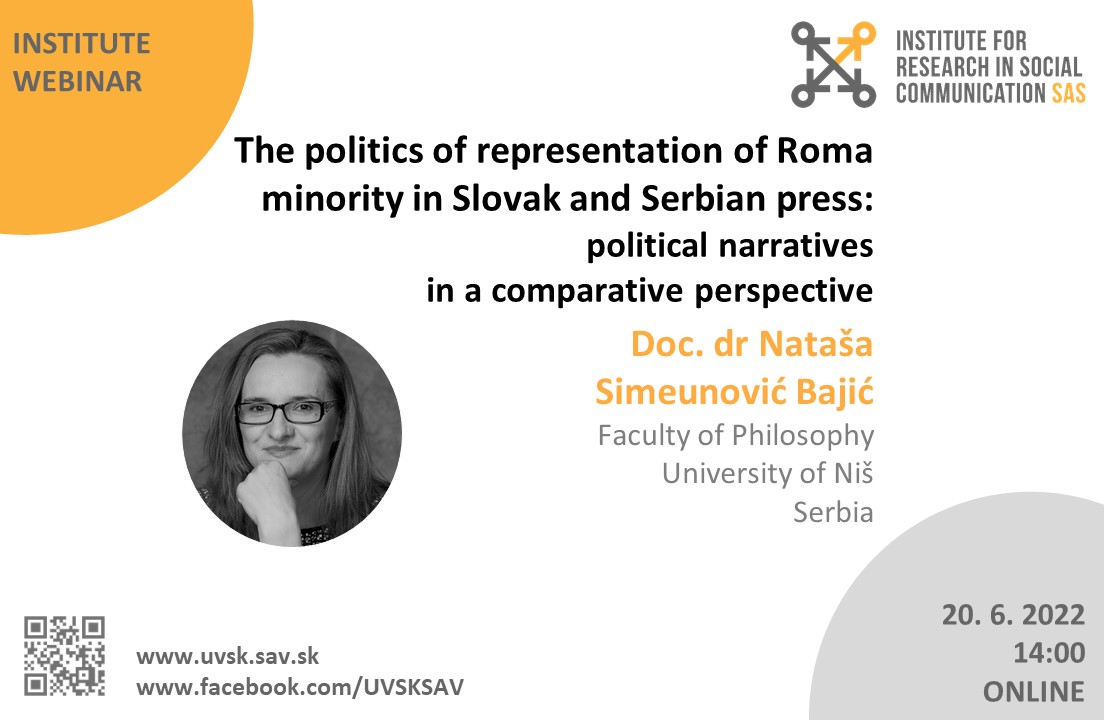Dear colleagues,
We cordially invite you to attend the Institute Webinar entitled “The politics of representation of Roma minority in Slovak and Serbian press: political narratives in a comparative perspective”, where we will welcome a guest. Nataša Simeunović Bajić from University of Niš will present her work and the project she focuses on while staying as a guest researcher at our institute thanks to SAIA fellowship. Please feel free to share the invitation with your colleagues.
The seminar will take place online. If you are interested in participating, please fill out the simple form: https://forms.gle/FAWzLSPc7Z33Cz6G9 by 19th June.
On the day of the seminar, you will be sent Zoom meeting access details. The maximum number of participants outside of the institute is 50 persons.
Link to the Facebook event: https://www.facebook.com/events/559576892273079?ref=newsfeed
We are looking forward to meeting you!
The politics of representation of Roma minority in Slovak and Serbian press: political narratives in a comparative perspective
Nataša Simeunović Bajić, University of Niš
Monday, 20.6. 2022, 14:00 – 15:30 CET, online
The Roma is an ethnic minority that has long been present in Europe. The oldest sources on the history of the Roma date from the 9th, 10th, and 11th centuries AD. Roma is real nomads, without their territory, ie. non-territorial and transnational minority (Barany, 2002). They are one of the most patriarchal and archaic ethnic groups in Europe. Many European states developed very difficult and exclusive treatment of Roma people. They experienced an exceptionally high degree of intolerance, discrimination, and segregation.
In Serbia and Slovakia, the Roma minority faces social exclusion. The Roma suffers from limited access to schools, jobs, and healthcare in both countries (Bednarik et al, 2019; Jakšić&Bašić, 2005). In light of the demographic picture of the Roma minority, the non-official estimation of the Roma population in Slovakia is up to 400.000 people, and in Serbia also around the same number. According to the last population census, the official number of Roma in Slovakia is 105,000 (2%), and in Serbia 150.000 (2.1%). Regarding all similarities and differences between Slovakia and Serbia, I am particularly interested in the comparative research on the politics of representation of the Roma minority. In order to place these aspects in a socialist and post-socialist context, I move beyond the conventional disciplinary boundaries. Research on the politics of media representation of the Roma is very important because the media are not only intermediaries in the social reality, but also its creators. Political narratives occupy large media space in Slovakia and Serbia. Politics of representation is created in the processes of permanent selection, which implies the simultaneous exclusion of certain topics and the emphasis on others. Based on media images, stories, pictures, and texts, the audience draws certain conclusions regarding the attitude towards members of this minority. For this reason, formed attitudes, as well as stereotypes about the most socially endangered minority in both countries, are largely dependent on media coverage and politics of representation. This research primarily uses the historical background and comparative approach. I analyze the corpus of political themes and micro-frames in the most important Slovak and Serbian press published over several decades, from 1989 to 2019. The research shows how certain political frameworks, themes, and discursive statements about the Romani minority change over time and what the role of the press in this process is.







